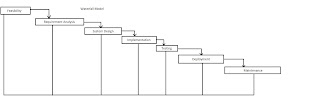Software Development Process Models

1.Waterfall Model This was the first process model and it is very easy to understand and use. In this model, you should finished the previous phase completely and moving to next phase. At the end of each phase, there is a testing to know whether the project is going right way or not. After this testing, the project is decided to continue or discard. This type use for, Small and permanent projects Clear requirements Static technology Enough resource and expertise Advantages Easy to understand and use Easy to manage Phase complete at one time Quality and cost control for each step Separation of tasks Process appearance Disadvantages Cannot go back Not suitable for complex, long and on-going projects High risky and unclear 2.Evolutionary Development Model In this model, there are many Software Development Life Cycles. Each cycle has a feedback from customer. Here develop the core module first and build next modules on that....



